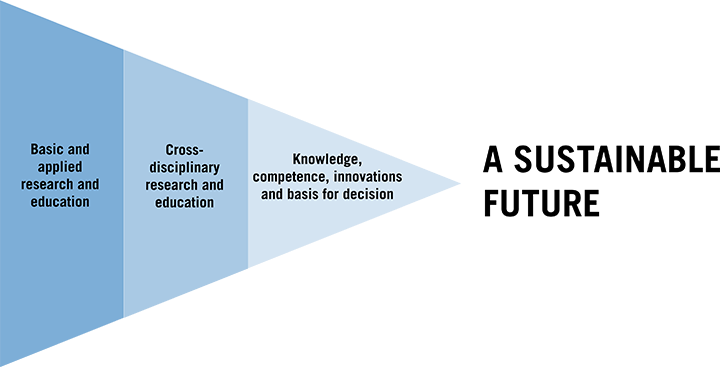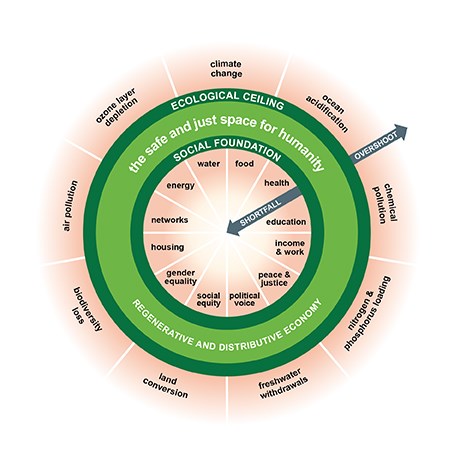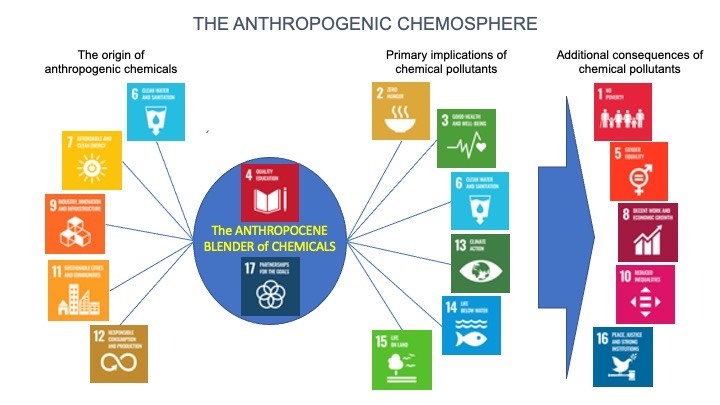About Platform for a Sustainable Future, PSF@ORU
About us
Platform for a sustainable future at Örebro University, PSF@ORU, is based on the premise that we must fundamentally change society in order to create a sustainable future. An important component of this transformation is the access to and development of new and scientifically grounded knowledge that can form the basis for conscious and systematic decisions by all actors in all functions of society – from the national to the global level. The most important purpose of the platform is to contribute to necessary changes by developing such knowledge through research and education and through interaction with society outside the university. The platform will initiate and facilitate multidisciplinary research and education within Örebro University in cooperation with the surrounding society.
Our vision is an inclusive and prosperous welfare society that operates within the planetary boundaries of the earth’s ecosystem.
Multidisciplinary for sustainable development
Multidisciplinarity means fundamental knowledge in the appropriate subject areas built on a firm theoretical base. When these basic knowledge areas meet, opportunities are created for scientific advancements and innovation. This interaction is the basis for generating new science and discoveries with a potential for innovations that can contribute to informed and updated decision making, and present potential solutions to societal problems and challenges. In other words, multidisciplinary research creates understanding that can be communicated widely and forms the basis for measures and decisions in society and for communication at a universal level in society as a whole.

Our view of sustainability
We have an integrative view of the concept of sustainability where we see nature and society (or culture if you will) as interconnected and inseparable. The result is a complex interaction between nature/ecosystems and human/social systems which we call socio-ecological systems [1] and which in everyday speech can be understood as ‘Society & Environment’. This means that sustainability can be seen as both a condition and a process that can be measured and analyzed.
As a condition, sustainability refers to our society being in the space below the boundaries of an imagined planetary ceiling [2], but above the lowest acceptable level of social and human development [3]. In this space between the planetary ecological ceiling and the social foundation, we can create a long-term globally sustainable society, characterised by equality and justice with good welfare, social security, good health, chemical safety, limited climate impact, a balanced and resilient economy, strong biodiversity, prosperous ecosystems, high natural values, and good quality of life for both current and future generations.

As a process, sustainability means taking action to change current systems and contexts. This is so as not to deplete ecosystems or social systems and actively counteract social injustices. We call it transformative learning [4]. Transformative learning emphasizes the need to continuously recognize, evaluate and re-evaluate the assumptions and expectations that form the framework for our actions, thoughts, and feelings. For the platform, it is about systematically developing science-based knowledge of what is required in terms of both transformative learning and actual transformation of socio-ecological and economic systems to create a sustainable future for all people and to show possible ways to get there.
An example is the anthropogenic chemosphere depicted in the figure below [5].

Chemosphere is a collective term for all the chemical substances and foreign substances (eg., antibiotics, medicines in general, additives to plastics, chemicals in skincare products and cosmetics as well as the biological and abiotic transformational products of these substances) that are found in our socio-ecological systems. These substances are a result of human activities from our industrialized societies and economic systems and make such an extensive imprint in the history of the planet that they are called 'anthropogenic', i.e., non-natural substances. The word Anthropocene comes from the epoch defined by the fact that the geological imprint is characterized by human activity. Many of the chemical substances generated by human activities are hardly even known and their effects have not been mapped. How they interact with each other and in ecosystems is knowledge that we largely lack today. Sustainability as a process means, for example, a better understanding of the chemosphere and its dynamics.
Sustainability as a process thus means working to stay within the planetary boundaries, but also working for a development that enables all people to stay above the social floor.
Our view on the complexity of sustainability
An important reason why it is difficult to reach sustainability is the interconnect between the earth's ecosystems and society's systems. This creates a high degree of complexity [6] and entails, among other things, that many goal conflicts arise. For example, production of sustainable fossil-free energy may be prioritised over production of grain for food due to the demand for biofuel. In a country like Sweden, this may not make a huge difference, but in a country with a partially starving population, as well as at a global level, it is a major problem. This means that a change in one system that, at least initially, seems promising, may have repercussions in other parts at a different time and at a different level. Such feedback between systems is characteristic of open dynamic systems with non-linear changes and emergence [7].
Emergence denotes contexts where rules and regularities at the micro level of a system cannot predict patterns or paths at the macro level that develop as a result of micro-level interactions. Conversely, macro-level patterns cannot exhaustively explain or justify micro-interactions or regularities at the micro-level. An example might be water. It is not enough to just study the interaction between hydrogen and oxygen and how these elements form stable molecules at the micro level to, for example, understand and be able to utilise the different properties of water (although such studies are also needed!). How water reacts to pressure, temperature, electrical charge, sound waves, etc. is better studied at the macro level by considering water as a cohesive element (or system if you will) with certain properties and functions, and to try to understand and explain these.
The same applies to the understanding of the interaction between social institutions and individual action, or between markets and market participants, and so on. For example, it is difficult to comment on the appearance of a specific stallholder by studying a number of local markets. It is equally difficult to comment on the development of the market by studying individual transactions in the market, since the market's development pattern is governed by all the transactions that are made and that are superimposed and interact with each other. This interaction gives rise to characteristics of the market that simply do not exist in the stallholders or even in a specific transaction. But without stallholders, no transactions and without transactions, no local markets and vice versa. This is emergence.
This complexity contributes to our need to understand how different levels interact and create complex dynamics. This gives rise to questions of goal conflicts and extensive system interconnections, which can make them difficult to study and understand. This is characteristic of sustainability problems.
Challenges for a sustainable future
In order to create a sustainable future, it is important to ensure that all people on earth have a chance at a reasonable standard of living and socio-economic development in order to achieve at least a minimum level of well-being, welfare, health and security [8]. In addition, people must be given the opportunity for education and learning. Together, this constitutes the social foundation of society.
At the same time, there are a number of relevant problems and sustainability issues that cause societal tension. One example involves quantifying the boundaries and scope of the planetary systems that have not yet been quantified. Identifying sources, risks and acceptable levels for chemicals is one such task, which may be suitable for a specific field of research or a scientific discipline (e.g. chemistry and toxicology), while issues related to social security may be suitable for another (e.g. sociology). Other issues, such as the role and impact of specific industrial activities on some specific ecosystems and how such activities can be made more sustainable, require cooperation between several disciplines, e.g. environmental science, chemistry, and economics.
Matching subject fields and scientific disciplines to research problems is a central process in the platform's function and forms part of the specification and formulation of research problems. The list of domains and problems that can potentially contain sustainability challenges is long. It basically includes all parts of our modern society and makes one thing abundantly clear: to meet the sustainability challenge, society must be fundamentally transformed and not one subsystem at a time, but in a massive process where the various systems interact and take new paths forward [9]. Understanding this process and developing relevant knowledge to support decision-makers in the process is the primary purpose of PSF@ORU, which breaks it down into different parts and steps without losing overall focus. PSF@ORU contributes by gradually and systematically developing scientific knowledge about transformative learning and about the transformation of our socio-ecological and economic systems for a sustainable future.
References
[1] Reyers, B., Folke, C., Moore, M.-L., Biggs, R., & Galaz, V. (2018). Social-ecological systems insights for navigating the dynamics of the Anthropocene. Annual Review of Environment and Resources, 43(1), 267-289. Clark, W. C., & Harley, A. G. (2020). Sustainability Science: Toward a Synthesis. Annual Review of Environment and Resources, 45, 331-386.
[2] Rockström, J., Steffen, W., Noone, K., Persson, A., Chapin Iii, F. S., Lambin, E., . . . Foley, J. (2009). A safe operating space for humanity. Nature, 461, 472-475. Steffen, W., Richardson, K., Rockström, J., Cornell, S. E., Fetzer, I., Bennett, E. M., . . . Sörlin, S. (2015). Planetary boundaries: Guiding human development on a changing planet. Science, 347 (6223).
[3] Raworth, K. (2017). A Doughnut for the Anthropocene: humanity’s compass in the 21st century. The Lancet Planetary Health, 1, 48-49.
[4] Boström, M., Andersson, E., Berg, M., Gustafsson, K., Gustavsson, E., Hysing, E., . . . Öhman, J. (2018). Conditions for Transformative Learning for Sustainable Development: A Theoretical Review and Approach. Sustainability, 10(12), 4479.
[5]: HERA Consortium (2021). EU Research Agenda for the Environment, Climate & Health 2021 – 2030. Final Draft. www.heraresearcheu.eu.
[6] Clark, W. C., & Harley, A. G. (2020). Sustainability Science: Toward a Synthesis. Annual Review of Environment and Resources, 45, 331-386.
[7] Simon, H. A. (1965). The Architecture of Complexity. General Systems (10), 63-76. Sawyer, R. K. (2004). The mechanisms of emergence. Philosophy of the Social Sciences, 34(2), 260–282.
[8] Raworth, K. (2017). A Doughnut for the Anthropocene: humanity’s compass in the 21st century. The Lancet Planetary Health, 1, 48-49. Millennium Ecosystem Assessment (2003). Ecosystems and Human Well-Being: A Framework for Assessment. Washington, DC: Island Press.
[9] Clark, W. C., & Harley, A. G. (2020). Sustainability Science: Toward a Synthesis. Annual Review of Environment and Resources, 45, 331-386. Bennett, E. M., Biggs, R., Peterson, G. D., & Gordon, L. J. (2021). Patchwork Earth: navigating pathways to just, thriving, and sustainable futures. One Earth, 4(2), 172–176.
